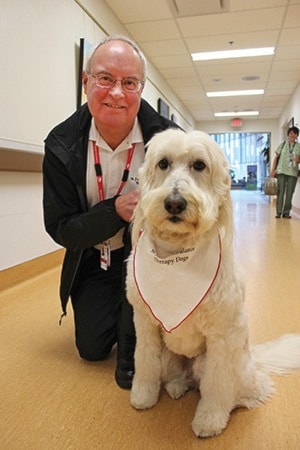Walking into the lobby at Royal Jubilee Hospital, Mia the dog is already surrounded by people, wagging her tail and eager to be pet.
Within minutes, a second woman comes up to say hello as Mia inches closer, dragging her red and green holiday leash towards her. The six-year-old golden doodle is incredibly friendly, approaching most people she passes in the hallways of the hospital.
“She’s a social butterfly,” says Mia’s owner and handler, Oak Bay’s Peter Beliveau.
It’s all fun and games until Beliveau pulls out a white and red kerchief – that’s when Mia’s real work begins.
Mia is one of 40 therapy dogs with Victoria’s St. John Ambulance dog therapy program – she even has an ID card to prove it. As part of the program, certified therapy dogs and their handlers visit patients in Island Health facilities around Greater Victoria to provide a friendly visit and talk about life beyond facility walls.
Twice a week for the past year and a half, Mia and Beliveau have visited patients in the geriatric psychiatric ward at Royal Jubilee Hospital and at the dementia ward at Oak Bay Lodge, spending about an hour at each facility.
“What the dog does is acts as a bridge between you and the patient. It’s amazing how people will respond to the dog and then allow you, or the handler, to become involved with them,” said Beliveau, adding unlike service dogs, therapy dogs are focused on the emotional and cognitive aspect of a patient.
“It’s amazing how you bring a dog into a situation and it brings down barriers ... When a patient becomes more comfortable then they start talking to you.”
Beliveau originally stumbled across the program online. After retiring in 2014 from his job as an emergency room doctor for nearly four decades, Beliveau found he often missed interactions with patients and colleagues. He also noticed how well Mia responded to most people, seniors and those in wheelchairs, and decided to give the volunteer program a try.
After an evaluation in 2014 with St. John Ambulance, Beliveau and Mia joined the ranks.
When the pair first started, Beliveau admitted some people were apprehensive, but when they see Mia, that quickly changes to talking and petting.
In one incident, a man with dementia wanted to get into a room that wasn’t his at Royal Jubilee. A nurse attempted to redirect him by convincing him to go back to his room. Shortly after the patient started screaming and the nurse was about to call security, when Beliveau and Mia walked up to him.
The patient started to pet her and within seconds, the pair were walking the man to the lounge.
Many of the patients Mia and Beliveau sees are seniors, however, the volunteer dog therapy program also visits students at university campuses during exam time, children at elementary schools and libraries where kids can read to the dogs and their handler.
“Interactions with the dogs lowers stress, the focus is on the dog,” said program coordinator Liz Barlow. “If you have a focus, the symptoms reduce. (Dog therapy) is calming . . . it lowers anxiety levels so much.”
It’s a program that has grown in the past few years, from only two dogs and their handlers in 2013 to 40 today.
Barlow has a dog named Nikki that her husband often takes to the Mount Tolmie seniors facility as well.
While any type of dog can become a therapy dog, not all have the right skills.
According to Barlow, dogs must be over two years old, have the right temperament, good leash skills and a good relationship with the handler.
For more information about the program visit sja.ca/.
